Overview
Within This Page
The Food Service space type includes cafeterias, sandwich shops, coffee shops, fast food retail, and other food services that involve the preparation and handling of food items for the consumer. Food Service space types are distinguished from other spaces where food may be vended (such as employee lounges) by the health and sanitation requirements related to the handling of unpackaged food products and/or processing of non-disposable dishware.
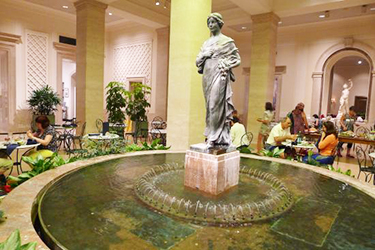
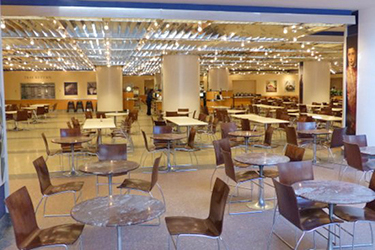
Left to Right: The Garden Café and the Cascade Café offer different dining options and experiences; both are within the National Gallery of Art in Washington, DC.
Space Attributes
Unique to the Food Service space type is a floor plan that must accommodate several distinct areas, each with specialized equipment and HVAC requirements. These areas include: food production, service, and dining; receiving and storage; and space for general circulation and other support areas. The integration of these systems should also facilitate proper cleaning and sanitation of all spaces where food is handled.
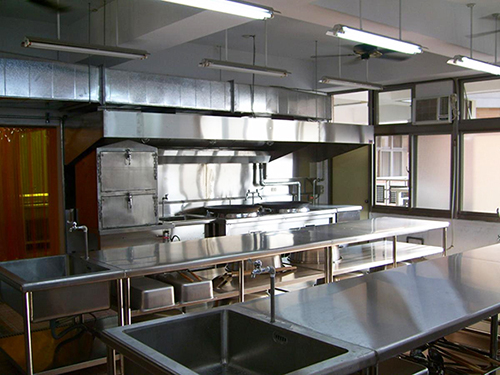
A clean and sterile kitchen and food prep area in a food service facility.
Typical features of Food Service space types include the list of applicable design objectives as outlined below. For a complete list and definitions of the design objectives within the context of whole building design, click on the titles below.
Accessible
In general, entrances, food service areas, dining areas, and restrooms should comply with ADA standards.
Path of travel: The path of travel around self-serve stations, ordering, pick-up counters, and seating areas should be designed with enough clear space for people using wheelchairs, other mobility aids, or service animals, especially when chairs are pulled out and occupied.
Seating: Dining areas should include accessible seating for wheelchair and scooter users and be spread throughout the seating areas. Design storage spaces for accessibility devices so that they are not in the way of other diners or servers.
Accessible tables: Table-top surfaces should be no higher than 34 inches above the floor with a clear space underneath at least 27 inches high, so that wheelchair users can get their feet and knees under the table.
- Menus: Menus and food labels should be accessible to all diners at a reachable height and in large print, high contrast, and non-glare to accommodate persons with low vision.
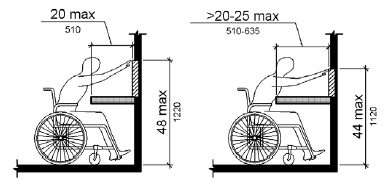
This approach to self-service and/or buffet lines provides wheelchair access underneath, ensuring that all items are within reach.
Aesthetics
- Dining Areas: These areas typically can include entry, waiting, seating, and condiment support. These areas will typically be designed for consumer comfort and will include aesthetic features such as ambient lighting, pleasing colors or artwork, and durable furnishings and finishes. A clear circulation plan within and around the dining areas will allow for simultaneous circulation of patrons and staff. Design the space for flexibility so that tables and seating can be rearranged or reconfigured for large groups and special events.
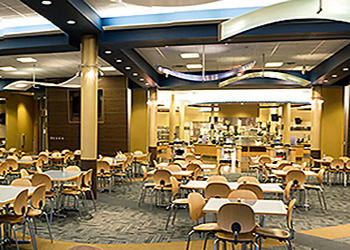
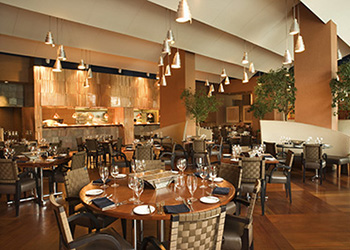
Two different dining and food service styles.
Cost-Effective
Coordinate the planning of the kitchen and equipment with a cost analysis that takes into account the menu, style of food offered, and the overall design goals.
Plan for efficiencies in every aspect of the kitchen, food service lines, dining areas, and other support spaces. Optimizing the kitchen with ergonomic design that combines design, function, and efficiency will make it easier for employees to multi-task and work effectively. This will also lead to cost savings without affecting the quality of the food or speed of service.
- Select materials, equipment, furnishings and finishes that are durable to reduce maintenance and replacement costs.
Functional / Operational
Service Areas: Service areas typically include the tray service lines, counters, packaged goods display, beverage dispensing, check out, and service ware dispensing.
Receiving and Storage Areas: These areas typically include dedicated food service docks, general dry goods storage, ventilated storage, and refrigerator and freezer storage (pre-manufactured modular units with integrated shelving). Design for a live load of 150 LB/SF in these areas.
General Support Areas: Support areas can include but are not limited to areas where little food production is taking place such as administration and staff areas for the dietician and manager offices, procurement and budget offices, staff lockers and toilets, staff lounge, and staff dining areas.
Sanitation and HVAC Requirements: The sanitation system for the Food Service space type generally will include the following areas of specialized equipment: dish wash, pot wash, garbage disposal, and janitor service. To ensure heat and odors associated with food preparation and handling do not permeate throughout the building, this space type requires a 20% increase in cooling capacity above building shell and core provisions, and a separate air return. Kitchen areas will have their own air handler units and dry chemical system hoods. In food production areas, provide ducted exhaust (welded black steel construction) to all cooking equipment hood vents with filter systems at discharge to reduce cooking odors.
- Occupancy Group: Occupancy classification for the Food Service space type is Assembly Occupancy A2, with sprinklered protected construction and 2-hour separation from other occupancies and GSA Acoustical Class X space where noisy operations are located. See also WBDG Secure / Safe—Fire Protection.
Productive
- Food Production Areas: Food production areas generally refer to preparation, cooking, pantry, and bakery areas. Equipment typically found in food production areas includes: modular refrigerator/freezer unit, a cooking section with eight burner range, broiler, salamander, deep-fat-fryer, roasting oven, steam kettles, steam cookers, mixer, pot rack, slicer, can opener, scale, knife rack, cook's table, spice bin, utensil shelves, hot food tables, mobile dish storage and a baker section with baker's bench, mobile bins, worktables, scale, mixer, bowl doll, tilting steam kettle, lighted oven, batch warmer, can opener, dough divider, dough roller, humidified proof box, power sifter, utility carts, dish carts, pastry stove, and bread slicer.

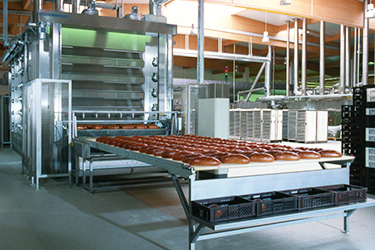
Food service preparation methods may vary, from hand-prepping vegetables to large-scale baking in commercial ovens, depending on the size and focus of the food service facility.
Sustainable
Sustainable food service is a growing trend and there are many approaches to designing the space to achieve this goal. A comprehensive sustainability plan will include everything from the ordering, delivering, storing, and packaging of food to the optimal use of energy, water, and food resources in the kitchen, prep and dining areas. Outlined below are a few sustainability issues to consider and plan for.
Incorporate energy and water efficient appliances, fixtures, and high-performance HVAC systems.
Use green building materials to provide a healthy indoor environment for workers and diners.
Plan for recycling and efficiency to reduce waste in all areas of the food service operations and dining spaces.
Increase natural daylighting whenever possible to reduce energy use and to improve the quality of the work spaces and dining experience. Use CFLs or more efficient T8 and T5 lighting to augment natural lighting where necessary.
- Install smart building technologies such as digital demand controllers to control operation of water heaters, air conditioners, and refrigeration equipment.
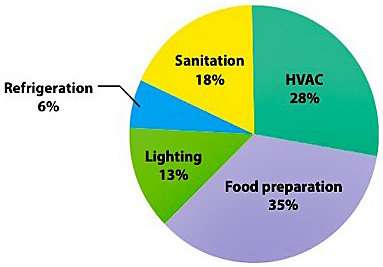
Energy consumption within the food service environment (IFMA 2009)
Example Program
The following is a representative building program for the Food Service space type.
FOOD SERVICE / CAFETERIA
| Description Tenant Occupiable Areas |
Qty. | SF Each | Space Required | Sum Actual SF | Tenant Usable Factor | Tenant USF |
|---|---|---|---|---|---|---|
| Customer Areas | 3,717 | |||||
| Dining Area (200 seats) | 1 | 2080 | 2080 | |||
| Condiment Areas | 4 | 50 | 200 | |||
| Service Line (2-35ft lines) | 1 | 1197 | 1197 | |||
| Public Toilets (Male) | 1 | 120 | 120 | |||
| Public Toilets (Female) | 1 | 120 | 120 | |||
| Kitchen | 1,026 | |||||
| Meat Preparation | 1 | 200 | 200 | |||
| Bakeshop | 1 | 200 | 200 | |||
| Cold Foods | 1 | 106 | 106 | |||
| Vegetable Preparation | 1 | 120 | 120 | |||
| Range/Grill | 1 | 400 | 400 | |||
| Storage Area | 456 | |||||
| Receiving | 1 | 56 | 56 | |||
| Common-Dry | 1 | 240 | 240 | |||
| Refrigerated | 1 | 160 | 160 | |||
| Cleaning Areas | 399 | |||||
| Dish and Truck Wash | 1 | 230 | 230 | |||
| Pot Washing | 1 | 60 | 60 | |||
| Trash | 1 | 109 | 109 | |||
| Employee Areas | 440 | |||||
| Manager | 1 | 120 | 120 | |||
| Lockers | 2 | 40 | 80 | |||
| Toilets | 2 | 60 | 120 | |||
| Employee Dining | 1 | 120 | 120 | |||
| Office | 1 | 114 | 114 | 114 | ||
| Tenant Suite | 6,152 | 6,152 | 1.18 | 7,282 | ||
| Tenant Usable Areas | 7,282 |
Example Plans
The following diagram is representative of typical tenant plans.
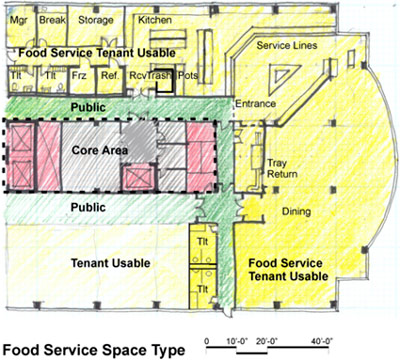
Example Construction Criteria
For GSA, the unit costs for Food Service space types are based on the construction quality and design features in the following tableDownload gsa_constr_criteria_foodservice.pdf . This information is based on GSA's benchmark interpretation and could be different for other owners.
Relevant Codes, Standards, and Guidelines
The following agencies and organizations have developed codes and standards affecting the design of Food Service space types. Note that the codes and standards are minimum requirements. Architects, engineers, and consultants should consider exceeding the applicable requirements whenever possible.
- Design Guidelines for the Visual Environment, Version 6Download LVDP_Guidelines_052815.pdf by the Low Vision Design Program. Washington, DC: NIBS, May 2015.
- GSA PBS-P100 Facilities Standards for the Public Buildings Service
- ICC IBC International Building Code
- UFC 3-190-07N Food Service Equipment Operation and Maintenance
- US Access Board, Americans with Disabilities Act (ADA) and the Architectural Barriers Act (ABA)
- US Green Building Council, LEED Green Building Rating Systems
Additional Resources
Organization and Associations
Publications
- Applying the ADA: Designing for The 2010 Americans with Disabilities Act Standards for Accessible Design in Multiple Building Types by Marcela A. Rhoads. New York, NY: John Wiley & Sons, Inc., April 2013.
- Architectural Graphic Standards, 12th Edition by The American Institute of Architects, Dennis J. Hall. New York, NY: John Wiley & Sons, Inc., 2016.
- Design and Layout of Foodservice Facilities, 3rd Edition, by John Birchfield. New York, NY: John Wiley & Sons, Inc., 2008.
- Food Service: Accommodating Diners with Disabilities by the ADA National Network, 2017.
Others
- Building Research Information Knowledgebase (BRIK)—an interactive portal offering online access to peer-reviewed research projects and case studies in all facets of building, from predesign, design, and construction through occupancy and reuse.










